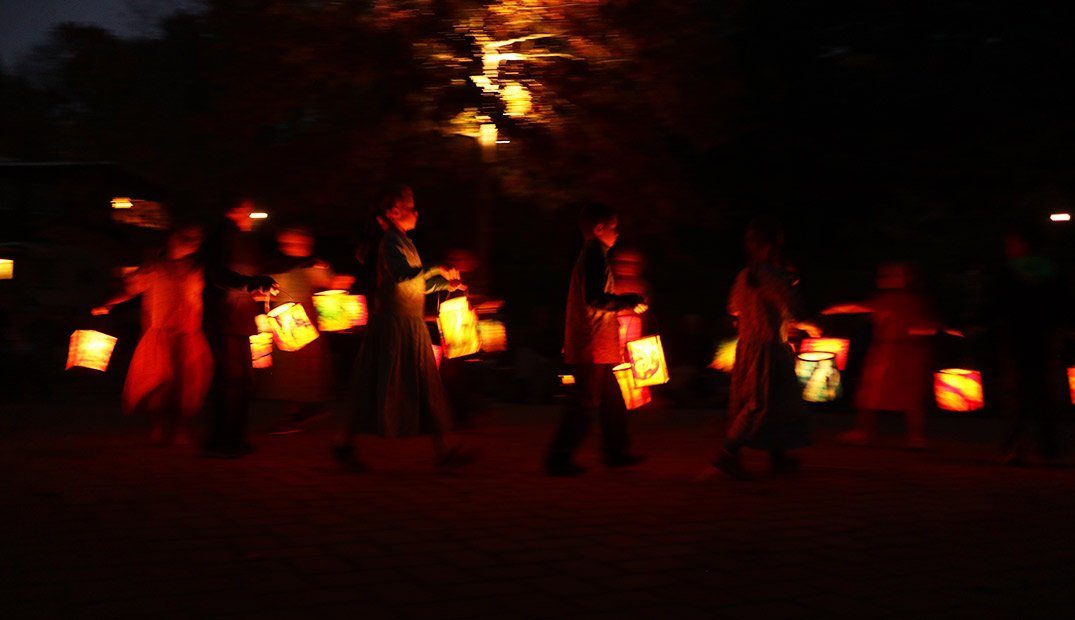The Beauty of a Lantern Walk
September 29, 2021 by Esther Keiderling
Cool weather brings pumpkins, colorful leaves, and the lantern walk. The lantern walk has happened every year at every Bruderhof community I’ve ever called home. We schedule it for an evening sometime between September and November. Everyone who can walk or be pushed in a wheelchair or stroller picks up a lighted lantern and forms a procession. The walk usually only lasts about a quarter mile so as not to exhaust the younger children, who are thrilled to stay up past their bedtime. Children love to swing their lanterns back and forth, creating a dancing blend of light and shadow while singing traditional lantern songs.
The lantern songs come from Germany, where many people celebrate November 11 by walking through the streets with lanterns in honor of St. Martin of Tours. The Bruderhof was founded in Germany and enjoys many of the best parts – in my opinion – of German culture. Although we do not strictly adhere to St. Martin’s day for scheduling our lantern walk, we have never in my memory had a year without one.
Although my favorite part is the doughnuts we eat together after the lantern walk, I also really appreciate looking back along the procession of people and seeing a whole row of lights. I cannot see the people but I can see the lights that they hold. They look beautiful.
It’s sometimes helpful to consider the light within people, especially people who I see every day. On the Bruderhof we live very close to each other, usually in multi-family apartment buildings and often sharing a kitchen area with two families. There are many opportunities for friction and disagreements. I sometimes get unjustly irritated at people whose actions I misinterpret. Sometimes people get unjustly (or justly) irritated at me. I hope that if anyone else looks at the procession of lanterns they don’t see me either, but only the light that I hold.
For anyone who wants to try making a lantern, there are many ways to go about it. When I make lanterns, I usually start by creating a wooden frame to hold the candle. The frame has a base – the candle holder – four round dowels sticking up from the four corners and attached to a ring of wood at the top which will later allow someone to reach in and light the candle. Then I attempt to decorate a large strip of paper to glue around the outside of the frame for the light to glow through. Have confidence in your artistic ability – you can easily make a lantern. If you would come join a Bruderhof lantern walk you would see that while some lanterns have watercolor paintings, others are covered by joyful crayon scribbles.
There are also safe options for kids. My first lanterns until I was at least five years old were the bottom half of a plastic milk carton to which I glued tissue paper. A flashlight or electric candle glowed through the tissue paper quite pleasantly. In elementary school I started using “big kid” lanterns with lighted candles. I would decorate the lantern myself and swing it proudly. Sometimes the lantern walk was disrupted for me or one of my peers when a candle tipped over (too much proud swinging?) and burned a hole in the lantern we had carefully created. We would put the lantern on the ground and blow it out with help and instruction from our parents and the plentiful adults around us. No one ever got burned, although I often shed a quiet tear in the darkness at the destruction of my masterpiece. But I still had the sturdy wooden frame, and knew I could make a new paper covering for it next year.
Recently the way to give my life meaning has become a lot more obvious. I believe that I have been given a lantern to carry. There are days when all I can do is keep my little flame alight. Other days I might tip my candle over and burn a hole in my lantern. At those times, plenty of people around are willing to help me blow the fire out and hand me a match to light my flame again. I have to forget my pride and keep carrying my disfigured lantern and joining in the song, not caring what others with beautiful, perfect lanterns think of me. Maybe they won’t see the burned paper anyway. It’s dark out here and easy to stumble. The most important thing is the light inside.
Esther Keiderling lives and works at the Fox Hill Bruderhof.

